 |
 |
 |
| |
48-Week Results from BENCHMRK-1, a Phase III Study of Raltegravir (RAL) in Patients Failing Antiretroviral Therapy (ART) with Triple-Class Resistant HIV-1
|
| |
| |
Reported by Jules Levin
CROI 2008, Boston
D.A. Cooper1, J. Gatell2, J. Rockstroh3, C. Katlama4, P. Yeni5, A. Lazzarin6, X. Xu7, R. Isaacs7, H. Teppler7, B-Y. Nguyen7 for the BENCHMRK-1 Study Group
1University of New South Wales, Sydney, Australia; 2University of Barcelona, Spain; 3University of Bonn, Germany; 4Hospital Piti Salptrire, Paris, France; 5Hospital Bichat-Claude Bernard, Paris, France; 6San Raffaele Scientific Institute, Milan, Italy; 7Merck Research Laboratories, PA, USA
AUTHOR CONCLUSIONS
In HIV-infected, treatment-experienced patients failing antiretroviral therapy with triple-class resistant HIV:
· Raltegravir 400 mg b.i.d. plus OBT has potent and superior antiretroviral and immunological efficacy compared to placebo plus OBT, which is sustained through Week 48.
- In patients receiving new, active antiretroviral therapies in OBT,up to 89% achieved HIV RNA < 50 copies/mL at Week 48.
· Virologic failure is generally associated with mutations at one of two primary residues, Q148 or N155, in combination with at least one other mutation.
· Raltegravir 400 mg b.i.d. plus OBT is generally well tolerated, as compared to placebo in combination with OBT.
- Few adverse events leading to discontinuation.
- Risk of developing malignancy is comparable between raltegravir and comparator groups, whether only the Phase III data are examined, or all Phase II and Phase III data are included.
Abstract
Background: In 3 studies of HIV-infected patients (pts) with limited treatment options, RAL with optimized background therapy (OBT) was generally well tolerated and provided superior viral suppression for ³24 weeks compared to OBT alone. These are the follow-up 48-week results from BENCHMRK-1 (Protocol 018), an ongoing multi-center, double-blind Phase III study conducted in Europe, Asia/Pacific, and Peru.
Methods: Pts failing ART with triple-class resistant HIV-1 were randomized 2:1 to oral BID raltegravir (RAL) 400 mg or placebo (PBO), both in combination with OBT. Pre-specified efficacy endpoints included % of pts with vRNA levels <400 and <50 copies/mL, and the mean change from baseline in CD4 cell counts.
Results: Of 352 pts randomized, 350 received ³ 1 dose of study drug. Baseline characteristics were comparable between the RAL and PBO groups. At baseline, median CD4 counts were 140 and 105 cells/mm3, and geometric mean viral loads were 4.6 and 4.5 log10 copies/mL in the RAL and PBO groups, respectively. OBT contained < 1 active drug (genotypic sensitivity score of 0) in 30% and 29% of pts in the RAL and PBO groups, respectively. Pre-planned 48-week efficacy analyses are shown below, along with the 24-week results:
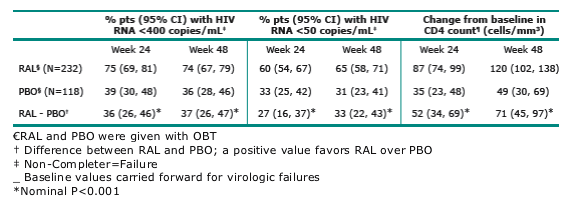
RAL was generally well tolerated over 48 weeks.
Conclusions: In this pivotal study of pts failing ART with triple-class resistant HIV, RAL plus OBT demonstrated superior antiretroviral and immunological responses compared to OBT alone, that were sustained out to 48 weeks.
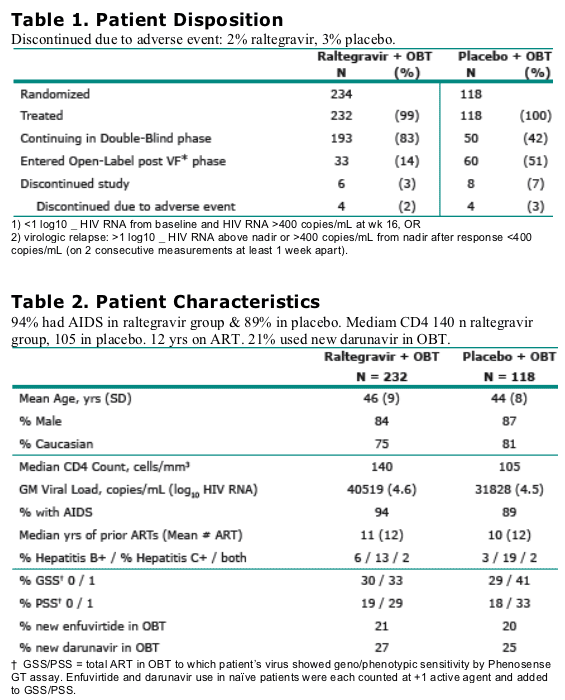
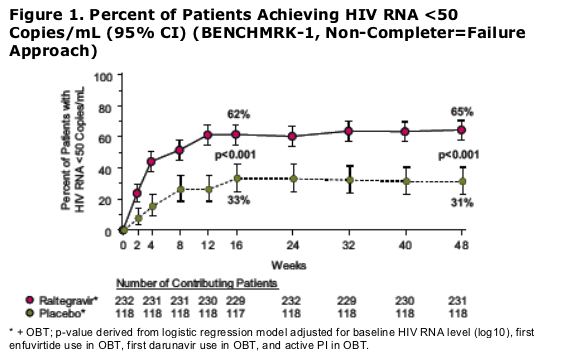
At week 48, HIV RNA <400 copies/mL was achieved in 74% of the raltegravir group vs 36% of the placebo group (p<0.001).
Data from BENCHMRK-1 & -2 combined
Efficacy by Subgroups
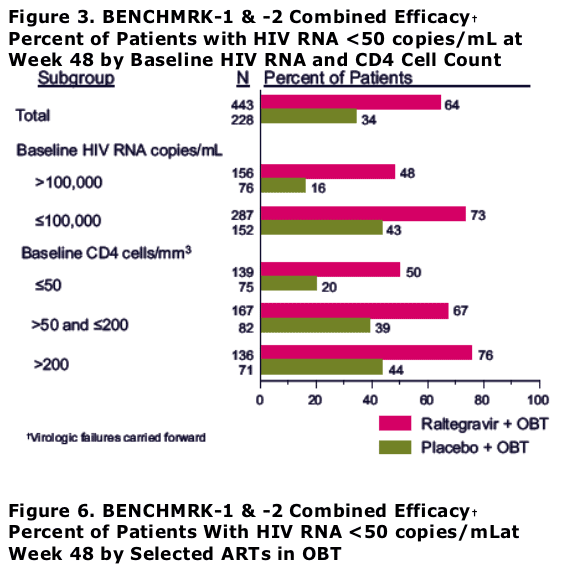
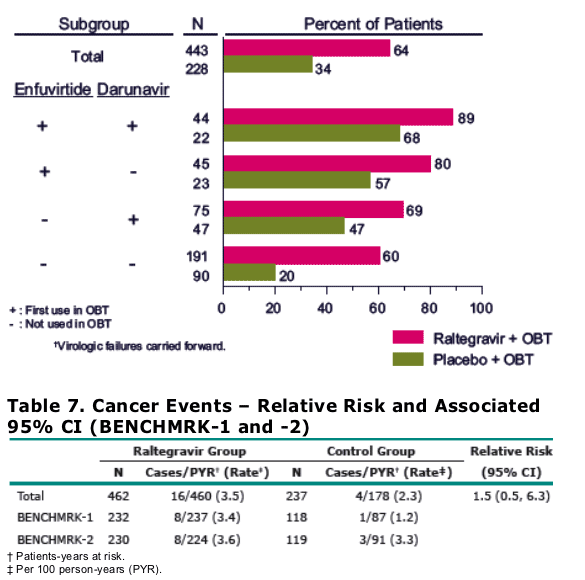
For a comprehensive assessment of risk, a similar analysis was done including all double blind data from Phase II and Phase III studies (Protocols 004, 005, and BENCHMRK-1 and -2), which provides a malignancy rate of 2.2/100 PYR for raltegravir and 1.8/100 PYR for the comparator group, resulting in a relative risk (95% CI) of 1.2 (0.4, 4.1).
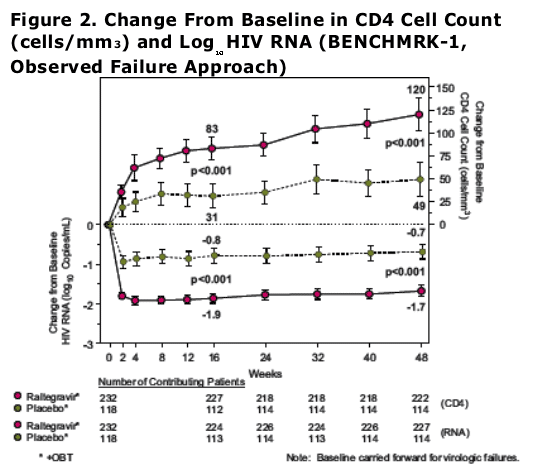
For change from baseline in CD4 cell counts, p-value was derived from a mixed-effects model adjusted for baseline CD4 cell count, stratum, treatment, visit, interactions between visit and previous variables. For change from baseline in log10 HIV RNA level, p-value was derived from a parametric regression model adjusted for baseline HIV RNA level(log10), first enfuvirtide use in OBT, first darunavir use in OBT and active PI in OBT.
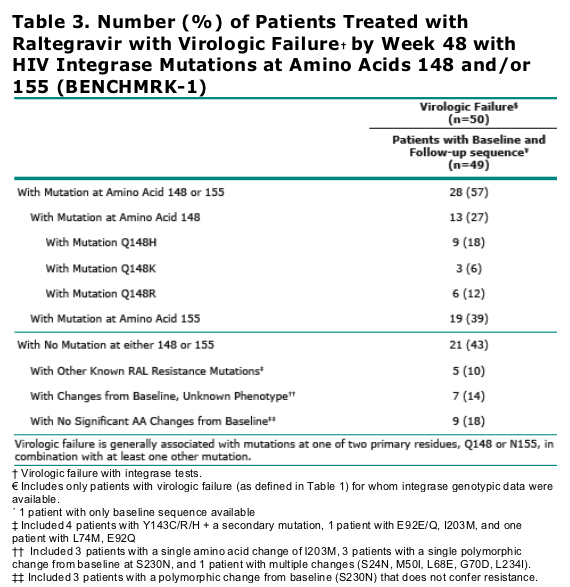
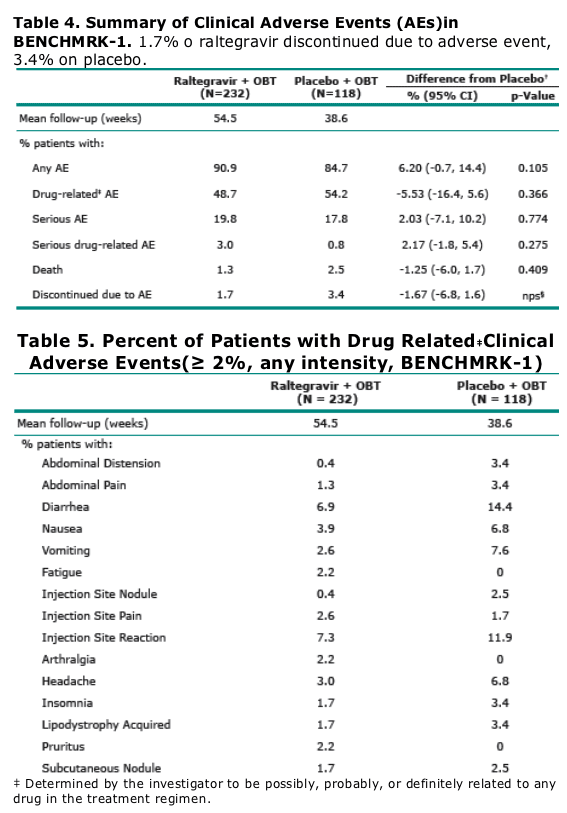
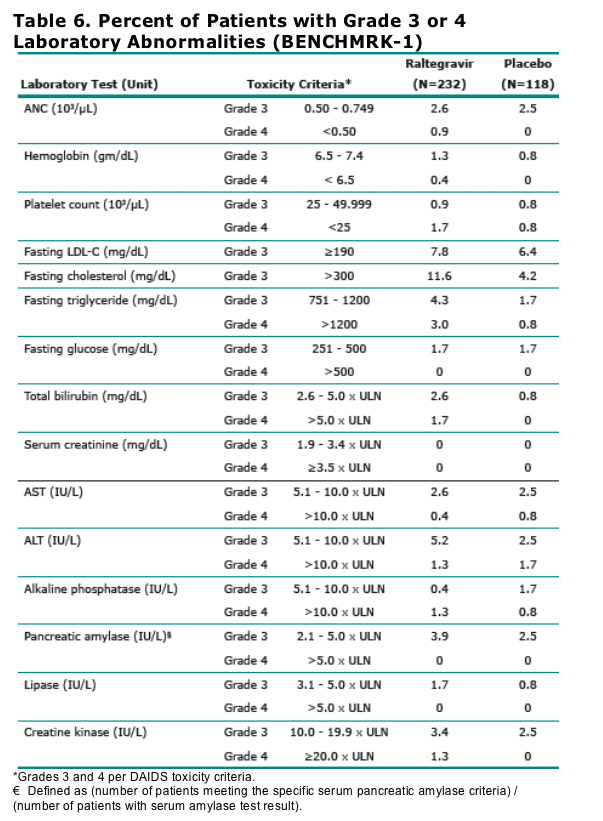
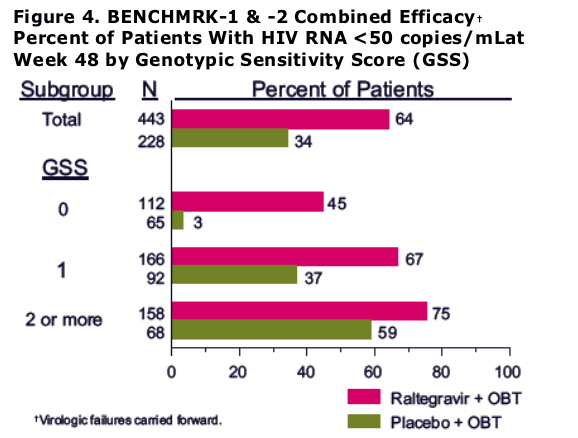
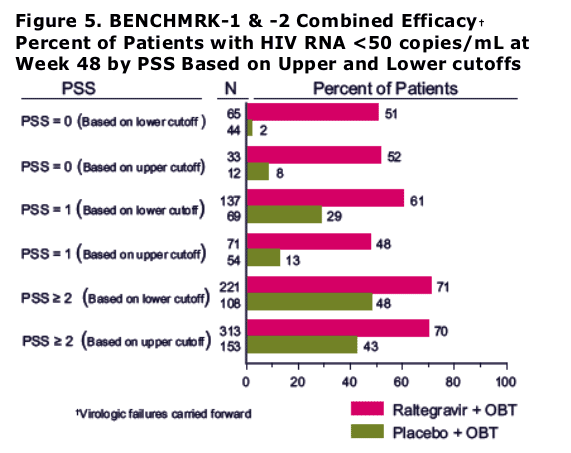
· The analysis by PSS score has been reanalyzed using the upper cutoff to better account for the impact of partial ART activity.
· Isolates with fold-change IC50 above the lower but below the upper cutoff are now reported as "partially sensitive". The upper cutoff was developed because the lower cutoff may underestimate partial ART activity in a regimen.
· At the time the BENCHMRK studies were initiated, only the lower cutoff was reported. The efficacy by PSS has been reanalyzed using the upper cutoffs, where available, to better account for the impact of partial ART activity.
Conclusion: At all levels of PSS, the results using the upper and lower cutoffs are similar, confirming the contribution of raltegravir in the treatment regimen.
|
| |
|
 |
 |
|
|